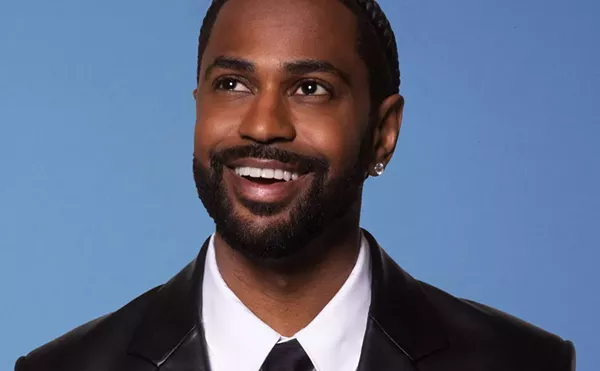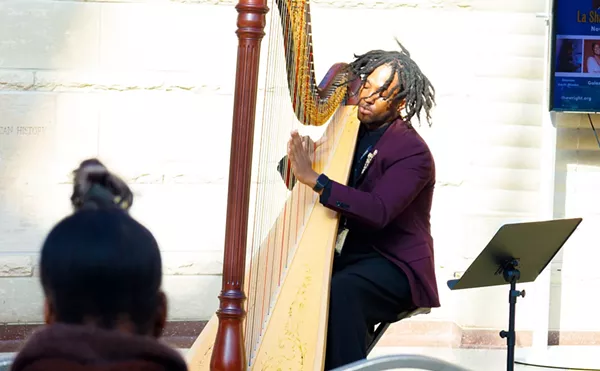
Audio By Carbonatix
[
{
"name": "GPT - Leaderboard - Inline - Content",
"component": "35519556",
"insertPoint": "5th",
"startingPoint": "3",
"requiredCountToDisplay": "3",
"maxInsertions": 100,
"adList": [
{
"adPreset": "LeaderboardInline"
}
]
}
]
In which two Metro Times editors and jazz fans consider a stack of recent releases as windows on the past and future of jazz.
Tysh: When I first heard “Hymn to the Mother,” the opening cut on Lift Every Voice, Charles Lloyd’s new two-CD set on ECM, I thought, “Here’s the ’60s infatuation with Eastern sounds all over again.” Especially following up on John Coltrane’s interest in raga forms and meditation, so many early-’70s recording sessions took this approach: Pharoah Sanders, Alice Coltrane, Don Cherry, John McLaughlin … all that Indian-sounding stuff. And then it just went away, as if nobody was interested anymore. It almost sounded corny after a while.
Heron: Lloyd seems to be getting back to the original inspiration for that again, rather than just going through the motions. He’s also using (the way some other records of the past few years have) old folk tunes and old, old standards. When he does spirituals like “Go Down Moses” and the folk tune “Wayfaring Stranger,” he continues the meditation into those other areas.
Tysh: And then he does Marvin Gaye’s “What’s Going On.”
Heron: … which is almost like a prayer here. It’s a very unusual version.
Tysh: Like a spiritual, it’s so affecting that it’s almost tearful, with an incredible elation to the point of sadness. Lloyd, at this time in his life, has this heart-on-his-sleeve sincerity about the music.
Heron: His tone in the ’60s was pretty aggressive, but now it’s almost dry — it reminds me of the way Stan Getz’s tone evolved late in his career. The runs that they play don’t have much in common, just the basic sound. Stan is much more out of Lester Young, and Charles has taken a longer route, more changes to get there …
Tysh: Though there’s still something Coltranesque about his playing. … Toward the end of Coltrane’s life, there was the feeling that his music was directed toward a “higher” purpose … and Lloyd is continuing that.
Heron: Another place where the Getz connection struck me was on the second disc when Lloyd does “Blood Count,” a Billy Strayhorn composition that Ellington recorded on And His Mother Called Him Bill after Billy’s death. It was originally a vehicle for Johnny Hodges, and I don’t think it was much recorded until Getz dusted it off late in his career. It became a very personal thing, because it was openly known that Stan was having a long fight with cancer — and Billy wrote the song when he was worried about his blood count when he was fighting leukemia. It has had a real meditative quality, willful and plaintive, from the time Hodges did it.
Tysh: Lloyd’s intense emotions here feel like a consciousness of mortality, another sign of his deep involvement in Eastern thinking.
Heron: Yet the set is fairly varied. There’s a cut, “East Virginia, West Memphis,” that starts in the modal drone like some of the other pieces and then it turns into this real stomp, with John Abercrombie on guitar just wailing away.
Tysh: We should mention the changes in Lloyd’s band here too. Detroit’s Geri Allen is on piano (she replaces Brad Mehldau in the quintet) and Billy Hart takes over for the late Billy Higgins on drums. Allen is more relaxed and stretched out here than she seems on her own sessions, and her playing is powerful and connected.
If we take off from this idea of Lloyd’s new approach to repertoire, we can go right into talking about Jason Moran’s Modernistic on Blue Note, which is really an amazing collection of solo piano pieces.
Heron: I heard his “Planet Rock” — his take on Afrika Bambaataa’s ’80s hip-hop hit — and it was one of those cuts where you stop everything you’re doing and hit repeat, hit repeat, hit repeat.
Tysh: Most of the compositions are his own, but he starts with stride-master James P. Johnson’s “You’ve Got to be Modernistic,” then he plays the standard “Body and Soul” in a very unstandard way, then plays “Planet Rock,” then a couple of his originals and somewhere in there includes Muhal Richard Abrams and Robert Schumann — talk about wild connections.
Heron: The eclecticism reminds me of Jaki Byard who would go from stride to “Ode to Billy Joe” to bop.
Tysh: Well, Moran studied with Jaki.
Heron: And he studied with Muhal as well, and he really shows it.
Tysh: I saw him give a concert recently at the Knitting Factory in New York — jaw-dropping solos that sounded like Bartok’s “Mikrocosmos” and Cecil Taylor and Jaki Byard, all with an ace rhythm section. I’ve never heard anybody play like that.
Heron: I can’t say enough about that “Planet Rock.” There are so many deft moves in those couple minutes of music. He comes out of “Body and Soul” and he starts with this kind of vamp that doesn’t really suggest what kind of tune you’re headed into. Then he brings the melody in very sparely, and it almost sounds like he’s got crinkly paper laid over the piano strings.
Tysh: Sort of like prepared piano.
Heron: And maybe evoking the sound of a piano roll so there’s an old-timey kind of feel.
Tysh: It’s like he’s taking Afrika Bambaataa and putting him back in the past. Moran is a great example of how jazz today brings together different strands of music: modernism, traditionalism, it stands in a way for the ultimate synthesis. Nothing is too high-brow or low-brow to be part of his music. Back in the ’50s you had to look to John Lewis and Gunther Schuller for this kind of fusion. But with those older guys, there was still a stuffiness to their classical music. I don’t get that feeling from Moran. Schumann’s got to come and hang. Moran is one of a whole group of younger interesting jazz pianists — Geri Allen, Brad Mehldau, Matthew Shipp — but he’s probably the only one with this feeling of all-inclusiveness.
Take his Schumann: When it starts out it makes Schumann and Bill Evans into the same person, which is cool because in a way when you hear Ellington, you realize he was listening to Ravel and when you listen to Ravel, you realize he was listening to Ellington.
Heron: It feels like all of a piece.
Tysh: Yet it’s not as easy a record to get into as you would think, as you would hope. When I first heard this record I was a little shocked by the extremes, but the more I listened, the more I realized that it flows.
Heron: While we’ve got artists like Jason Moran reinterpreting the past, we constantly have the jazz past quite literally resurfacing with reissues that come and go. I found the two-CD Wayne Shorter collection on Blue Note, The Classic Blue Note Recordings, to be one of the most interesting reissues of the year. It takes a sideways look at his career as a composer rather than just Wayne Shorter the leader. There’s a solid, if predictable CD of his recordings as a leader from 1964 through 1970, overlapping with his years with Miles Davis. The second disc is his work with other leaders playing his compositions, including Art Blakey and the Jazz Messengers. There are cuts from sessions with Freddie Hubbard and Lee Morgan from the ’60s, then a couple of ’80s bonus tracks with Michel Petrucciani and the Manhattan Transfer. Usually the function of these reissues is to sample the records you don’t already own. Even if you have a great collection of Blue Notes, this record lets you listen to Shorter the composer in a new way — unless you’re going to pull up all these records by various artists that he worked with and program your CD player to hit the Shorter cuts.
Tysh: It makes the point of what an important composer he is. All of those beautiful tunes for great bands, not to speak of his work with Miles’ band, the better Weather Report material, etc.
Heron: The standard canon of great jazz composers has Ellington and then Thelonious Monk and then who? Ornette? And after that Wayne Shorter has got to be pretty close to the front of the next group.
Tysh: The last record in the stack for today, Mat Maneri’s Sustain on Thirsty Ear, gets us back to the discussion of jazz fusion that we hit on with Lloyd and Moran. The beginning of it, the solo and overdubbed viola work from Maneri, really sounds like the 20th century classical composer Morton Feldman, one of his string compositions. And the Feldman feel returns a little bit when Craig Taborn comes in later on piano — before it just takes off. But it’s stunning to me how very much this is like Feldman: low dynamics, lots of space, wavering pitches that aren’t right on.
Heron: Well his father, Joe Maneri, was a free improviser back in the 1950s who taught microtonal composition at the New England Conservatory. This kid was probably raised on microtones. What strikes me about this record is its incredible sense of tension.
Tysh: That’s what I was wondering as this began. You eventually realize where this album is going with intense tunes like “Sustain” and “Nerve” particularly.
Heron: Sort of like Miles Davis right around Bitches Brew. And Maneri has an interesting mix of players, beginning with saxophonist Joe McPhee who’s been around since the late ’60s as a sort of underground, free jazz presence and the senior citizen of the recording session.
Tysh: You’ve got William Parker on bass, one of the totally great bass players today; I hate to make up those hierarchies of who’s the best, but he’s right up there. And then there’s Gerald Cleaver and Craig Taborn, both out of this area. They’re superb. And this is one of the more successful integrations of jazz material and new music … Moran is doing it all by himself on a solo record, but Maneri is taking things in a similar direction with experimental classical. “Nerve” grabs you right in your gut and moves your body so you can’t stop.
Heron: It’s a swirl of music, not a linear propulsion; it’s not straight-ahead so to speak. And like Lloyd it’s continuing elements from the ’60s, less the meditative side and more the furious side … and there’s a connection to jazz-rock fusion as well, to Miles and early Weather Report …
Tysh: But fusion wasn’t supposed to mean just opening jazz to rock; that was one kind of fusion. Here the idea is of opening to all sorts of things. Moran and Maneri are suggesting a fusion of contemporary classical experimental music and that’s where I’d say a lot of contemporary musicians — the younger ones, the most exciting ones — are today.
W. Kim Heron is the managing editor of Metro Times. E-mail wkheron@metrotimes.com




